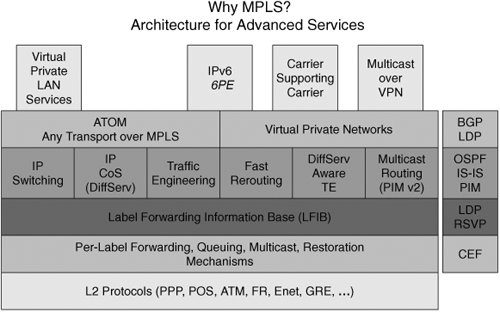MPLS Technology Details
| This section examines how MPLS facilitates the development of service types, such as Layer 3 VPNs and traffic engineering. Figure 3-7 depicts the MPLS advanced service architectural components that include Layer 3; traffic engineering; differentiated services; Layer 2 VPNs; Virtual Private LAN Service (VPLS); IPv6, multicast GMPLS; and the key control protocols, such as Label Distribution Protocol (LDP), BGP, RSVP, and so on, that activate these service functions. As mentioned previously in this chapter, one of the key benefits of the MPLS architecture is the separation into two planesone containing information required to transfer a packet (the data plane) and the other allocating the transfer information (the control plane). This separation permits applications to be developed and deployed in a scalable and flexible manner. Several applications that are facilitated by the implementation of MPLS include:
The sections that follow focus on the technology details for a base of these services, such as Layer 3 VPNs, traffic engineering, differentiated services, and Layer 2 VPNs. Multicast, IPv6, and GMPLS are discussed in later chapters. Figure 3-7. Architecture for Advanced Services |
EAN: 2147483647
Pages: 162